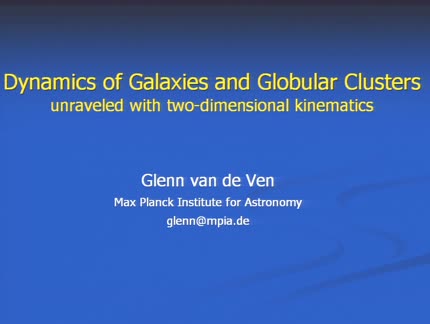Found 5 talks width keyword intermediate-mass black holes, IMBH

Abstract
With the aim of detecting cosmological gas accretion onto galaxies of the local Universe, we examined the Ha emission in the halo of the 164 galaxies in the field of view of MUSE-Wide (Urrutia+19) with observable Ha (redshift < 0.42). An exhaustive screening of the Ha images led us to select 118 reliable Ha emitting gas clouds. To our surprise, around 38 % of the time the Ha line profile shows a double peak centered at the rest-frame of the corresponding galaxy. We have explored several physical scenarios to explain this Ha emission, among which accretion disks around rogue intermediate mass black holes (IMBHs) fit the observations best. I will describe the data analysis (to discard, e.g, instrumental artifacts and high redshift interlopers), the properties of the Ha emitting clumps (their fluxes, peak separation, and spatial distribution with respect to the central galaxy), and the arguments leading to the IMBH hypothesis rather than other alternatives (e.g., cosmological gas, expanding bubbles, or shocks in the circum galactic medium).

Abstract
In this talk, I will review the recently discovered infinite-dimensional symmetries that emerge in the near horizon region of black hole horizons. I will explain how the conserved charges associated with those symmetries carry information of the black hole, and, in particular, about its thermodynamic properties. I will focus on the case of magnetized black holes; namely, black holes that are embedded in strong magnetic fields.

Abstract
The detection and number estimates of supermassive binary black holes (SMBBHs) provide important constraints on the hierarchical models for galaxy formation and evolution. I will present two different approaches for the possible identification of SMBBHs. 1.Radio-optical studies of X-shaped radio sources:X-shaped radio galaxies are extragalactic radio sources that present two pairs of radio lobes passing symmetrically through the center of the host galaxy, giving the galaxy the X-shaped morphology seen on radio maps.This morphology can reflect either a recent merger of two supermassive black holes or the presence of a second active black hole in the galactic nucleus. This scenario is studied by determining the mass, luminosity, jet dynamic age and starburst of a sample of X-shaped sources and comparing the results to a sample of radio-loud active nuclei with similar redshift and luminosities. 2.Compact radio emission in ULX objects: Ultraluminous X-ray sources (ULXs) have luminosities exceeding 10E39 erg/s, suggesting either the presence of black holes larger than stellar mass black holes or sources apparently radiating above the Eddington limit. I will present milliarcsecond-scale radio observations of some ULXs located within optical bright galaxies, resolving their compact radio emission, and measuring its brightness temperature and spectral properties. This allows us to uncover the nature of these sources and investigate whether they are intermediate mass black holes or supermassive black holes stripped of their accretion disks in post-merger systems.

Abstract
Two-dimensional stellar kinematics obtained with the integral-field spectrograph SAURON allow the classification of early-type galaxies into 'slow' and 'fast' rotators, different from their morphological classification into ellipticals and lenticulars. Most fast rotators, including lenticular as well as many elliptical galaxies, are consistent with oblate axisymmetric disk-like systems. On the other hand, the slow-rotator ellipticals show clear deviations from axisymmetry, which can be modeled with our extension of Schwarzschild's orbit superposition method to triaxial geometry. Besides galaxies, I show that Schwarzschild's method can also be used to model in detail globular clusters such as ω Cen and M15. The recovered internal orbital structure of ω Cen reveals besides a signature of tidal interaction, also a central stellar disk, supporting its origin as the nucleus of a stripped dwarf galaxy. The formally best-fit Schwarzschild model for M15 includes an intermediate-mass black hole, but we cannot exclude a model in which dark remnants make up the dark mass in the collapsed core.

Abstract
The centers of massive galaxies are special in many ways, not least because all of them are believed to host supermassive black holes. Since the discovery of a number of relations linking the mass of this central black hole to the large scale properties of the dynamically hot component of its host galaxy (bulge) it has become clear that the growth of the central black hole is intimately connected to the evolution of its host galaxy. However, for bulge-less galaxies, the situation is much less clear. Interestingly, these galaxy often host star clusters in their nuclei, and unlike black holes, these nuclear star clusters provide a visible record of the accretion of stars and gas into the nucleus. I will present my ongoing projects on nuclear star clusters that aim to understand their formation process and might give a hint on how black holes get to the centers of galaxies.« Newer Older »
Upcoming talks
- Classical Be stars - Constraining binary interaction physics in massive starsDr. Julia BodensteinerThursday April 25, 2024 - 10:30 GMT+1 (Aula)
- Runaway O and Be stars found using Gaia DR3, new stellar bow shocks and search for binariesMar Carretero CastrilloTuesday April 30, 2024 - 12:30 GMT+1 (Aula)









